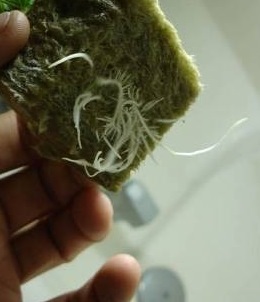Your Cart is Empty
The Ultimate Guide On Cloning Plants
December 08, 2018 8 min read

The Complete Guide On Cloning Plants
Not everyone knows that it’s possible to actually clone your favorite plants under the right conditions. Of course, this has nothing to do with advanced science. There’s no need for a fancy laboratory or the assistance from some sort of “mad scientist”. It’s a standard gardening practice that can provide certain benefits when compared with growing plants from seeds. As a matter of fact, cloning plants is a far easier procedure than you may think.
Methods for growing plants
For growing most types of plants you have to be aware that you can choose from a few types. First of all, there is sexual reproduction in which you cross female plants with male plants. This is accomplished through pollination, with the goal of producing seeds. When those seeds are planted, you then are able to grow genetic hybrids of the plants that you are using.
The second method involves cloning, which is referred to as an asexualform of reproduction. When we speak of ‘clones’, we’re referring to rooted plant cuttings which are identical (genetically) to the plant that the cuttings were taken from.This form of plant reproduction is popular with home growers as well as commercial growers.
If the cloning process is executed in the correct manner, you will have the benefit of saving money as well as ensuring that your garden is stabilized with identical and sustainable crops. The crops that you produce will consist of exact replicas of your original plants. Should you encounter a particular strain of plant that you favor, then you can continue growing that exact same kind of plant for as long as you wish. This will allow you to continue to grow particular plants that demonstrate desirable traits such as; yield amount, rapid growing time, flavor and other notable characteristics.
You will also be ensuring that your cloned plants are completely identical in their genetic profile. When this is done correctly, you never have to worry about taking any chances by introducing a harvest that comes from new seeds. In addition, you also don’t have to be concerned with any undesirable mutations that can occur when you are growing your plants through the use of sexual reproduction. And the best part is that you can engage in cloning your plants with relative ease, with just the use of a few necessary items. These items are:
-
A hormone designed for rooting
- A medium designed for rooting
- Distilled water (water with no chlorine)
- A clean razor for obtaining your cuttings (avoid scissors for this, since they tend to be inexact and can damage branches leading to increased cloning difficulty)
- Scissors for later leaf clipping

Rockwool Cubes And Coco Jiffy Pellets Are Commonly Used To Root Clones

For Higher Success Rates Ensure You Use A High Quality Root Hormone And Sanitised Scalpel.
Cloning considerations
The first thing that you’ll have to do is choose which plant you want to clone. Take note - if you come across a particular strain of plant that you become enamored with, you still have some things to take into account.
For example, when you are ready to select the plants to clone, look for plants that are no less than two months into their vegetative cycle. The plants should, of course, also be healthy and strong. If, for some reason, you don’t wish to wait the two months, you should at least wait three weeks prior to taking your first cuttings. The goal is to give your plants the best opportunity for rooting and plant maturity plays a part in this.
Tip: If your growing a seasonal plant you can keep a plant in the vegetative period for years as long as you keep the lighting on vegetation hours. This it typically referred to as a mother plant and allows you to take clones all year round.
Preparing your plants for cutting
Preparing your plants for cutting
When you’re ready to prepare your chosen plants for cutting these are the steps that you should take:
- Refrain from fertilizing your plants for a few days prior to cutting – the nitrogen will then have time to make its way out of the plant’s leaves. Too much nitrogen in the plant’s leaves and stems will cause your plant to attempt to grow more vegetation rather than diverting its energy to the rooting process.
- Do your best to work in a sterile setting. You don’t want any negative bacterial influences to harm your original plants and your new cuttings.
- Choose strong, healthy lower branches. For those who are transplanting your cuttings into rockwool, you will want to get the correct fit by matching your plant’s stems with the rockwool cube’s rooting hole. Otherwise try to just take plant cuttings that are 8-10 inches long and have a number of nodes.
- When performing your cutting, make your cuts as close as possible to your main stem. Cut at a 45 degree angle from the plant’s branch. This promotes quicker growth by increasing the rooting space’s surface area.
- Since you don’t want air bubbles to form in the stem, place the cutting into the water right away. Air bubbles prevent the future absorption of water and can actually kill your new clone. You can even choose to make a few additional cuts into the stem, before placing the cutting into the water in order to facilitate water absorption.
Rockwool or coco pellets?
There is a question of whether it’s better to use rockwool or coco pellets when cloning. Actually, you could consult a number of different growers and obtain a number of different answers. It pretty much boils down to the growing medium that you prefer on a regular basis. For example, some growers point to the fact that coco coir is very good for propagation when it comes to both clones and seeds. Since it holds a relatively limited water amount, it will provide an excellent medium if you don’t allow it to stagnate.
However, you need to take note that it has no nutrient value. So, you’ll want to feed your new plants a light nutrient solution and make sure to transplant as soon as healthy roots have emerged. You can also reuse coir, since you can sterilize it with UV and hydrogen peroxide and it keeps its consistence for a period of months. It’s also inexpensive.
Those who use rockwool claim that they like the fact that you can use it and not have to touch your new plant clone for a couple of weeks. It’s also noted that after cloning in rockwool, you can transplant your clones into any medium without too much fear of transplanting shock. It’s also inexpensive.
So the answer is really dependent on the type of growing medium that you prefer when growing your plants on a regular basis, since both coco pellets and rockwool have their own separate advantages. But there are also other schools of thought regarding cloning medium.
Some growers choose to transplant their clones directly into soil. However, if you do this, you don’t want to choose soil that contains a lot of nutrients. You should also take note not to either over- or underwater the soil when you’re in the process of rooting your clones.
Other growers may choose to root their clones in water. This form of cloning will require no medium or rooting hormone. Basically, you just place your cuttings into water and leave them there until the new growth starts.
Needless to say, these different schools of thought will have both their pros and cons. It’s suggested that you perform some experimentation's with different methods that you’d like to try beforeworking with your favorite plants. This will give you the experience that you need and will help to avoid any later disappointments. But, in any case, you’ll want to ensure that the new clones receive plenty of light and humidity. 18 hours of light a day is a good way to go.
For those with a busy schedule, there are even auto-cloners that are available on the market. These units will automatically provide your clones light, oxygen and water on a set schedule. However, they can be rather costly.

Clone Taken With Coco Jiffy Pellet

Clone Taken With Rockwool Cube

Clone Planted Within Soil
Cutting and transferring
Once you’ve taken your cuttings and have transferred them to the water, it’s now time for leaf clipping. The reason for doing this is that you will want to set up your new plants for supporting the necessary photosynthesis. You will also want to make sure that you provide a sanitary rooting environment.
Begin by clipping your fan leaves using your scissors. You’ll want to do this about halfway down the plant’s leaf stem. You’ll also want to remove any leaves that are not necessary in order to avoid having them touch your growing medium. This will assist your clones with water and nutrient absorption and also keep the leaves from touching each other.
Now is the time to dip the fresh stems in your rooting hormone. Rooting hormones come in a variety of brands and forms such as powders and gels and will provide additional growth and support. However, even though there are a variety of different brands on the market you will want to make sure that you choose a high quality one. Once you’ve performed your brief dip into your rooting hormone, then you will transfer the new clones into the final rooting/growing medium.
Rooting
After a period of time you will notice that your clones will begin to show new vegetative growth. This is the point when you should consider using a larger container in which to transplant your clones. It’s important to note that this particular process will require the same sanitation and care that you used in the initial cloning procedures. This will prevent your plants from going into transplanting shock, which is quite common when growers are cloning. However, you can limit the chance of this occurring if you take care not to traumatize your clones with the introduction of additional bacteria.
If you are new to cloning you may wish to know just how long it takes for your cuttings to begin to root. If you are cloning using rockwool or coco pellets, your cuttings will begin to root in about 5-10 days. Once these new roots appear, it’s suggested that you water them twice a day in order to keep them moist.
For clones that have been placed in water for them to root, the rooting will generally happen in 3-4 weeks – but some plants might take longer. You’ll be ready to pot the cuttings when the roots reach 2 inches or longer.
Propagation Lights (LED + Fluorescent)
When it comes to lighting, you don’t want to place your new clones under direct lighting. Only when you see the new roots, do you want to place them under gradual lighting. It’s when you see the production of vegetative growth that you can allow them full lighting with the rest of your garden. For clones, the light cycle should be 18 hrs. on and 6 hrs. off.
To help your clones avoid having any stress or shock having the correct light for them is a must. One of the ways that you can stress your new plants is through lighting that is too strong. For this reason, it is recommended that you use propagation lights for your cloning.
Propagation light is a low intensity light that can be either fluorescent or LED. They emit their light waves primarily in the blue light spectrum. By providing their moderate rays of light, they can support your plants without overpowering or stressing them. You can utilize either fluorescent or LED lighting however LED lighting provides stronger growth in our opinion.
Additional Cloning Items and Tools
As mentioned before, there are additional items that you can purchase, when it comes to making you plant cloning efforts easier and more successful. Taking a look online, you can find cloning aids such as:
- Sterile and individually wrapped scalpels for cutting
-
Heat mats – for maintain cloning environment temperature
- Heat mat thermostats – for controlling heat mat temperatures
- Propagation trays – Come in different sizes and can be used over and over
-
Humidity domes – These will fit standard propagation trays and are designed to protect taller cuttings. They can also be used for multiple seasons and can have adjustable ventilation holes.
- Specially designed cloning nutrients
- And many other cloning aids.
Overall, cloning your favorite plants is an easy and highly cost-effective way to maintain a consistent garden over an extended period of time. With just a moderate attention to detail, you’ll be able to enjoy the exact genetic species of your favorite plant for years to come.
Leave a comment
Comments will be approved before showing up.



